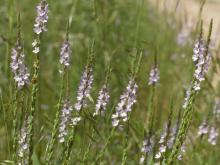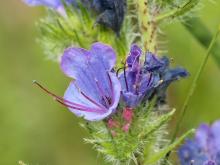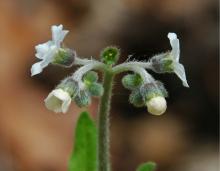Wildflowers, Grasses and Other Nonwoody Plants
Media

Species Types
Scientific Name
Viola sororia
Description
The common violet can be violet, white, or white with violet mottling or spots. One of 17 species or violets in Missouri, it occurs statewide in a variety of habitats. Note its heart-shaped or rounded, scalloped leaves, and (usually) the presence of hairs on stems and/or foliage.
Media

Species Types
Scientific Name
Phacelia purshii
Description
An annual, spring-blooming wildflower, Miami mist has loose coils of small blue flowers with distinctive, delicate fringes on the petal lobes.
Media

Species Types
Scientific Name
Camassia scilloides
Description
In spring, wild hyacinth bears an elongated cluster of pale blue flowers with prominent anthers that sway on stalks up to 2 feet tall.
Media

Species Types
Scientific Name
Ruellia strepens
Description
Although the funnel-shaped, 5-lobed flowers look something like the petunias you find at garden centers, our wild petunia is not related to them. This ruellia often has crinkled hairs in 2 narrow, lengthwise bands on opposite sides of the stalk.
Media

Species Types
Scientific Name
Triodanis perfoliata (formerly Specularia perfoliata)
Description
Clasping Venus' looking glass is a single-stemmed plant with purple or blue star-shaped flowers and bluntly toothed, alternate leaves that clasp the stem. It's scattered statewide in a variety of habitats and blooms May-June.
Media

Species Types
Scientific Name
Physostegia virginiana
Description
False dragonhead is called "obedient plant" because when you push one of the flowers sideways, it "obediently" stays in place for a while.
Media

Species Types
Scientific Name
Verbena simplex
Description
Narrow-leaved vervain is a short, slender perennial with single stems or with upper stems sparingly branched. Its many small flowers are crowded on narrow spikes. The corollas are tubular, deep lavender or purple, with 5 spreading lobes.
Media

Species Types
Scientific Name
Echium vulgare
Description
A biennial plant with bristly hairs and usually with single stems, viper’s bugloss can grow 2½ feet tall. The flowers are pink in bud, blue to ultramarine later. The protruding stamens are pink.
Media

Species Types
Scientific Name
Solanum carolinense
Description
Horse nettle is a native perennial with spiny stems and leaves, white to purplish flowers, and toxic fruits that look like tiny yellow tomatoes. It does well in disturbed habitats, and many people consider it a weed.
Media

Species Types
Scientific Name
Cynoglossum virginianum
Description
Wild comfrey has large basal leaves that are soft, hairy, and elliptical with long petioles — they look like hounds’ tongues! The upright flowering stalk has few leaves and looks like a wand.
See Also
About Wildflowers, Grasses and Other Nonwoody Plants in Missouri
A very simple way of thinking about the green world is to divide the vascular plants into two groups: woody and nonwoody (or herbaceous). But this is an artificial division; many plant families include some species that are woody and some that are not. The diversity of nonwoody vascular plants is staggering! Think of all the ferns, grasses, sedges, lilies, peas, sunflowers, nightshades, milkweeds, mustards, mints, and mallows — weeds and wildflowers — and many more!





















